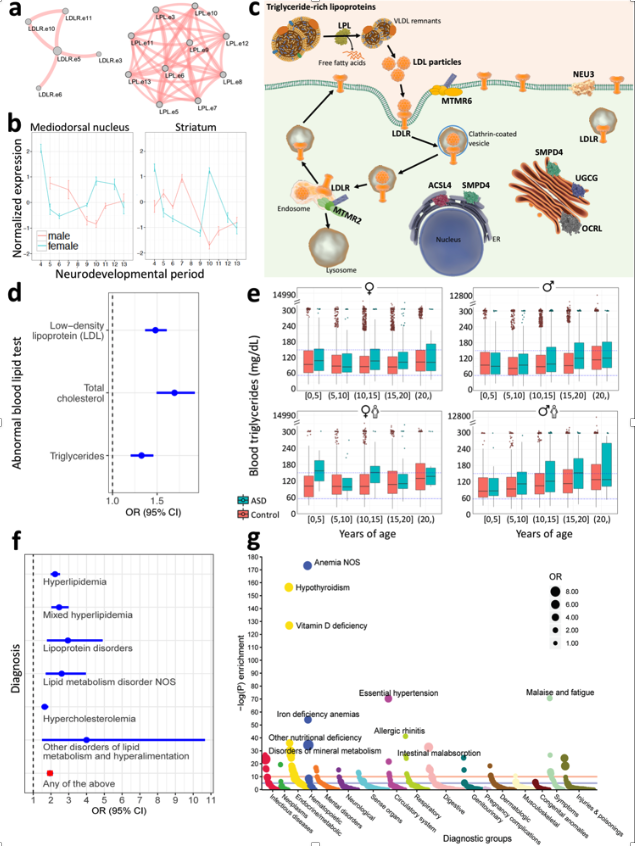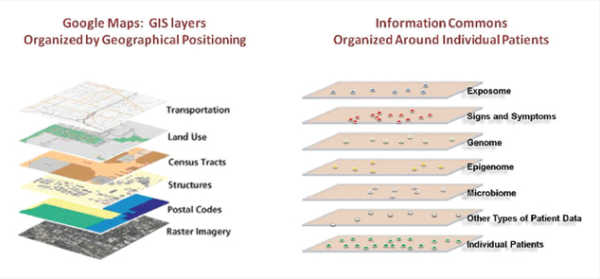I may get into the details below, but this recent publication in Nature Medicine gives me an opportunity to revisit the problematic validity and utility of the autism diagnosis. We took a clinical insight and used it to focus on genes that had dramatically different expression patterns during the critical period of brain development. We then whittled down that collection of genes to those that bore mutations/rare variants that were found through exome sequencing in patients with autism but not those (e.g. relatives) without autism. We found four functional groups of genes that were enriched in affected individual. One of these groups—lipid metabolism—has been given short shrift, if any, in previous genetic studies. A comprehensive review of mouse models in the Jackson Laboratory revealed that many mice with a “knockout” mutation in one of the lipid metabolism genes had behavioral characteristics very similar to classical mouse models of autism. But that’s mice. We also studied tens of thousands of individual humans with autism through their electronic health record or through their claims data. Even after correcting for treatments that might affect lipid metabolism we found a substantial increased prevalence of dyslipidemia in patients with autism relative to controls. Compared to unaffected siblings, the odds ratio was approximately 1.5 (150%). More studies, as usual, will be required to confirm this dyslipidemia-autism hypothesis but the question is raised should these individuals with dyslipidemia have the same diagnosis as those patients with autism and with, for example, a immune signalling disorder?

Figure: Convergence of Autism-segregating deleterious genetic varants on lipid regulation functions, clinically reflected by an association between altered lipid profiles and autism, as well as enrichment of dyslipidemia diagnoses in individuals with autism (see publication for full description).
As late as the 18th century, a diagnosis of dropsy was a diagnosis that reputable clinicians could make without embarrassment. This diagnosis of the abnormal accumulation of fluid only gave way to diagnoses of heart failure, liver failure or kidney failure causing fluid accumulation in the 19th century. By the end of the 20th century making a diagnosis of heart failure without distinguishing whether it was due to valvular disease, ischemic heart disease, genetically inherited myopathy or another dozen causes would raise eyebrows. Not only because it would be ignorant but because these different causes have differing natural histories and most importantly, differing optimal treatments. In that perspective the diagnosis of heart failure only informs us of a shared set of findings (e.g. symptoms, clinical measurements) which do not distinguish between the various causes nor provides and disease-specific guidance for prognosis or treatment. As we reveal mechanistically distinct causes of autism, many but not all genetic, we’ve seen the definition of groups of patients who have little in common other than the DSM criteria for autism. As we’ve shown, autism is clinically manifested in far more diverse ways than would be suggested by DSM. Just by studying electronic health record data we can distinguish subgroups of individuals who, in addition to the DSM definition, have epilepsy, immunological disorders (e.g. inflammatory bowel disease, type 1 diabetes mellitus, infections) or psychiatric disorders.
There is an obvious value to the diagnosis of autism that I’ve omitted. A sociopolitical one. All the diseases that have in common autistic findings collectively have prevalence of over 1%. That puts autism somewhere between the incidence of type 1 diabetes and skin melanoma cancer in Americans, each of which have benefited from appropriate and considerable private and public attention and support. The high collective prevalence of diseases with clinical manifestations of autism, regardless of other findings, has enabled important changes such as school support programs, massively increased research funding over the past two decades and progress in screening programs. At the same time, this lumping of different causes and clinical courses, just as for the example of heart failure, does create confusion among clinicians and researchers. It also causes hurt and acrimony for patients and their families which rapidly acquires political overtones as narrated by this NPR program.
“[in a] conversation between Ari Ne’eman, who is a very, very prominent and successful activist for the concept of neurodiversity. And Ari Ne’eman, whom we have a lot of respect for, has been very, very successful in promulgating the idea that people with autism should be accepted as they are. And he had a conversation with a mother named Liz Bell. Liz Bell is the mother of a young man named Tyler. In his mom’s opinion, Tyler’s experience of autism is very, very limiting in his life and his ability to dress himself, to shave himself, to feed himself, to go out the front door by himself and not run into traffic. And these are two very, very different views of what autism represents that come down to the fact that the spectrum is so broad that there is room for an Ari Ne’eman on it and there is room for a Tyler Bell on it. And the basic disagreement between them is whether autism is something that should be cured — whether the traits that limit Tyler’s ability to be independent in life should be treated to make those traits go away. On one side, Ari is saying that it’s suppressing who he actually is and his identity; on the other side is Tyler’s mother saying that to treat him, and even cure him, of his autism would be to liberate who he is.”
Similarly, in research studies there is a point at which lumping all the different disorders is less helpful than splitting them apart. Just as for heart failure in the 21st century, realizing there are different underlying diseases allows advances in diagnostic accuracy but also in therapeutic efficacy. In the Undiagnosed Disease Network, we’ve shown again and again that more detailed clinical characterizations (aka deep phenotyping) are at least as important as whole genome sequencing in arriving at a diagnosis for these patients on long and difficulty diagnostic journeys. Several of the patients seen in the Undiagnosed Disease Network had findings fully consistent with autism in addition to other findings that led to the investigations that discovered a new disease.
I could easily go on for thousands of words about the challenge and opportunity for modern diagnostic approaches. I’ll forestall the temptation by referring to a National Academy of Sciences report on Precision Medicine that I had the privilege to contribute to. This report was often misunderstood as arguing for molecular, genome scale characterizations of disease. This was only true in part and missed the central contention. Our argument was that by examining groups of patients and finding what they had in common using multiple data modalities (see the figure from the report, below) clinical, environmental monitoring, epigenetic, microbiome, we acquired more relevant, scientifically and clinically, diagnostic perspectives.
This multiaxial perspective of diagnosis influenced the direction of our investigation as intentionally styled in this diagram from the supplementary figures in the publication, below.

These findings of a subgroup of patients with autism who have dyslipidemia are of course just the beginning of a set of follow-on investigations. As in much of science, a useful investigation poses more questions than it answers, How does a disorder of lipid metabolism during neurodevelopment cause pathophysiologies that include findings of autism? Would early detection help treatment? Would normalization of lipid metabolism during neurodevelopment affect the course of disease? Which specific perturbations of lipid metabolism have the largest impact on neurodevelopment? These are questions which could not be posed with an overly rigid and monolithic definition of autism. Now, with the multiaxial approach of precision medicine, many more such questions can be asked and investigated.
